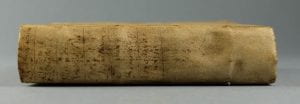Conserving controversial literature: access and safe handling
By Erika Delbecque, on 20 May 2019
This blog post was written by Marina Pelissari, MA Book Conservation student at Camberwell College of Arts
For the Final Project of my MA in Book Conservation at Camberwell College of Arts I was given a semi-limp vellum binding to conserve by UCL Special Collections. This volume contains five early 17th-century controversial tracks, including texts against Islam, Catholicism, and Astrology, as well as a copy of Daemonology, written by King James I, about demons and sorcery.
The five books have a parchment cover with boards made of recycled blind tooled leather, which is an unusual re-use of materials for this kind of binding. The main problem concerning the use and handling of this volume is that the text block is detached from its cover. The alum-tawed sewing supports that make this attachment are completely broken.

This book is used as a teaching aid in seminars at UCL, where students can examine it closely. Being an interesting book for its content as well as its binding, it is important to ensure its accessibility and its safe handling. To ensure these, the conservation project included, along with the extension of the sewing supports to re-lace the parchment cover, surface cleaning, repairing the paper tears and losses, repairing and flattening the distortions of the parchment.

Left: Alum-tawed leather extensions of the sewing supports. Right: Parchment cover being tension dried by using magnets.

The parchment cover has yet another interesting feature: the spine shows faded manuscript writing. Thanks to a collaboration with the UCL Special Collections Conservation Studio and PhD student Cerys Jones (UCL Medical Physics and Biomedical Engineering), a further analysis of the spine cover by using multispectral imaging revealed the content of the writing and shone more light on the history of the book. We all accompanied Cerys in the imaging session, where she explained the process.
Multispectral imaging has been used to recover lost features in heritage materials, such as text and drawings. This process involved illuminating the object with ultraviolet, visible and infrared light, while pictures of the different steps were taken. The multispectral images enhanced the contrast between parchment and ink, so as to making the writing legible, since parchment is fluorescent under ultraviolet light, whereas ink is not.
The images obtained showed six sentences separated by horizontal lines. The last five were immediately identified as the titles of the aforementioned five books, and they appear in the same order as the books are bound. The first title, however, did not correspond to any recognizable book within the volume.
 At the beginning it was thought that it could be a title given to the collection. After a closer analysis, Cerys and Erika Delbecque, the Head of Rare Books at UCL, identified the writing as “Anatomy of Abuses”. Further researches revealed that this is the title of a pamphlet written by Philip Stubbes, first published in 1583. In his book, Stubbs “condemns such vices as usury, gluttony, promiscuity and excessive expenditure on clothing as behaviour unfitting a true Christian, and further denounces both popular entertainments and traditional rural festivals as enticements down the road to hell and damnation.” (Kidnie, 1996).
At the beginning it was thought that it could be a title given to the collection. After a closer analysis, Cerys and Erika Delbecque, the Head of Rare Books at UCL, identified the writing as “Anatomy of Abuses”. Further researches revealed that this is the title of a pamphlet written by Philip Stubbes, first published in 1583. In his book, Stubbs “condemns such vices as usury, gluttony, promiscuity and excessive expenditure on clothing as behaviour unfitting a true Christian, and further denounces both popular entertainments and traditional rural festivals as enticements down the road to hell and damnation.” (Kidnie, 1996).
This discovery has suggested the theory that the volume had a first pamphlet bound together with the other five. “Anatomy” had six editions. The last one, dated 1595, contains 144 pages printed in the quarto format, which is the same format as the other books contained in the volume. The presence of the title on the cover and the content of the tract, that matches the others in its controversial nature, make it seems plausible that “Anatomy of Abuses” was part of the volume. However, it can be argued that there is not enough space in the binding to contain it, since the cover is already somewhat short for the text block. At this point, it is only possible to speculate, without drawing any certain conclusions.
The conservation treatments are currently under way. The final result will be shown during the final exhibition of the graduates from the MA Conservation at the Camberwell College of Arts, between the 18th and the 23th of June, which is open to the public. The book will then be available as a teaching aid for UCL students and for research at the Special Collections.
 Close
Close


